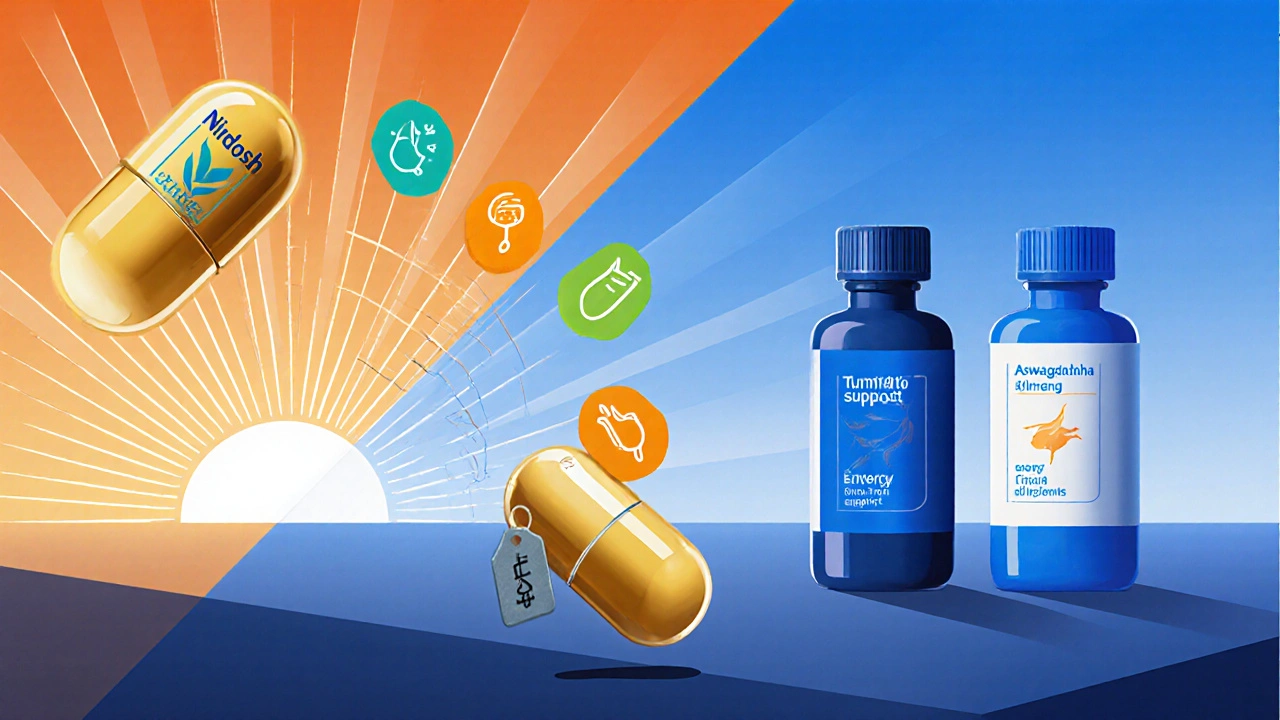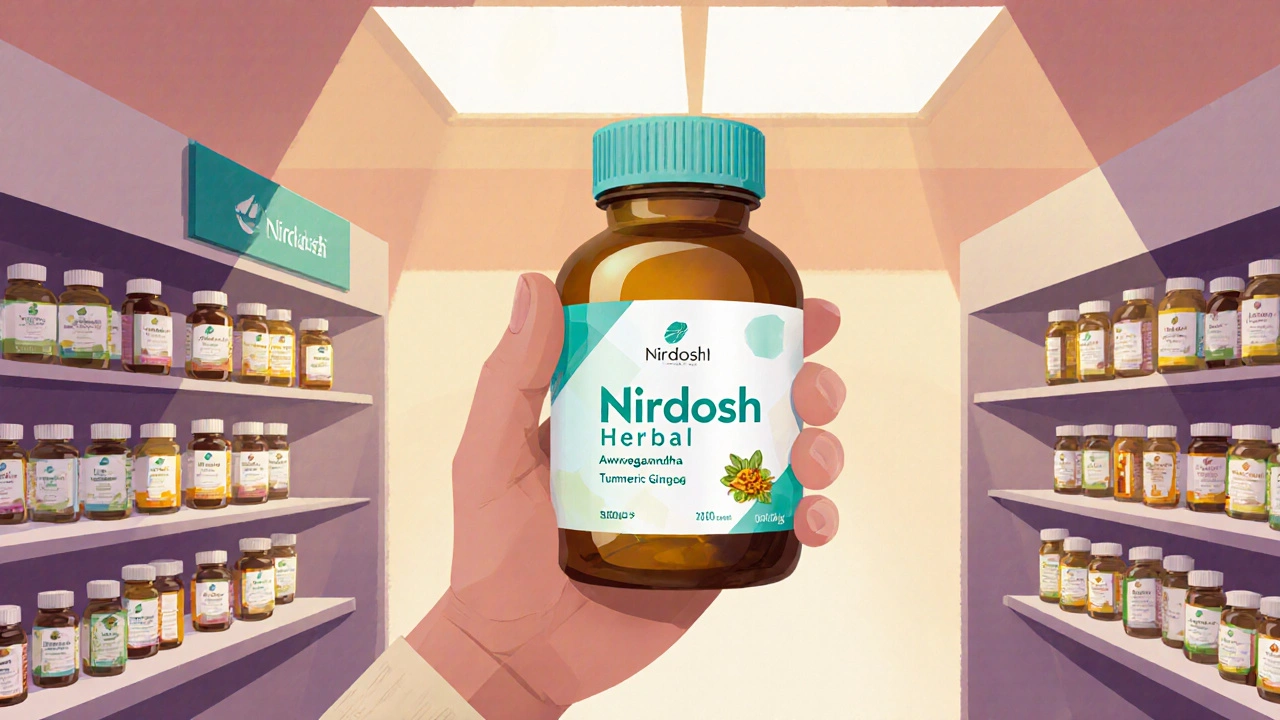Herbal Supplement Cost Calculator
Find the most cost-effective herbal supplement for your needs
Select your primary health goal to see which supplement provides the best value
Key Takeaways
- Nirdosh Herbal offers a blend of traditional Ayurvedic herbs aimed at stress relief and energy support.
- Compared to single‑herb adaptogens like Ashwagandha or Turmeric, Nirdosh provides a broader spectrum of active compounds.
- Price per dose is higher than most stand‑alone alternatives, but the multi‑herb formula may reduce the need for multiple supplements.
- Potential side effects are mild and mostly related to digestive comfort; users with thyroid issues should check iodine content.
- Choosing the right product depends on your specific goals - single‑herb focus vs. broad‑spectrum support.
When shoppers hunt for a natural boost, they often stumble upon Nirdosh Herbal. The brand markets it as an all‑in‑one Ayurvedic formula for stress, stamina, and overall well‑being. But does it really outperform other popular herbal options, or is it just another shelf‑filler? This guide breaks down the ingredients, benefits, pricing, and safety profile of Nirdosh Herbal and pits it against five widely‑used alternatives: Ashwagandha, Turmeric Curcumin, Ginseng, Maca Root, and Rhodiola Rosea.
Nirdosh Herbal is a proprietary blend of six Ayurvedic herbs, including Withania somnifera (Ashwagandha), Curcuma longa (Turmeric), Glycyrrhiza glabra (Licorice), and others, formulated to support stress resilience and physical performance. The product is sold in 60‑capsule bottles, each capsule delivering roughly 500 mg of the combined extract. Manufacturers claim standardised levels of withanolides, curcuminoids, and flavonoids, but third‑party lab results are limited.
How Nirdosh Herbal Stacks Up - The Core Ingredients
Understanding any supplement starts with its ingredient list. Below is a quick snapshot of what you get in a single Nirdosh capsule:
- Withania somnifera (Ashwagandha) - 150 mg
- Curcuma longa (Turmeric) - 100 mg
- Glycyrrhiza glabra (Licorice) - 80 mg
- Phyllanthus emblica (Amla) - 70 mg
- Terminalia chebula - 60 mg
- Eleutherococcus senticosus (Siberian Ginseng) - 40 mg
Each herb brings its own active compounds: withanolides from Ashwagandha, curcuminoids from Turmeric, glycyrrhizin from Licorice, vitamin C from Amla, and eleutherosides from Siberian Ginseng. The blend aims to hit multiple pathways - cortisol reduction, antioxidant support, and mitochondrial energy production - in one pill.
Alternative #1: Ashwagandha - The Solo Adaptogen
Ashwagandha is an adaptogenic root used in Ayurvedic medicine to lower stress hormones and improve stamina. Most standalone supplements contain 300-600 mg of a full‑spectrum extract, often standardised to 5 % withanolides. Users report reduced anxiety scores after 4-6 weeks. Side effects are rare but can include mild stomach upset.
Alternative #2: Turmeric Curcumin - The Anti‑Inflammatory Powerhouse
Turmeric Curcumin is a bright yellow spice rich in curcuminoids, famed for its anti‑inflammatory and antioxidant properties. Effective formulations combine 500 mg of curcumin with 5 mg of piperine to boost absorption. Benefits include joint comfort and improved digestion. High doses may cause gallbladder irritation in sensitive individuals.
Alternative #3: Ginseng - The Energy Booster
Ginseng is a root (Panax ginseng) that stimulates the central nervous system and is traditionally used to enhance physical performance. Typical daily doses range from 200 mg to 400 mg of a 5 % ginsenoside extract. Users notice a modest lift in mental focus, but the effect can wear off after a few weeks, leading to tolerance.
Alternative #4: Maca Root - The Hormone Balancer
Maca Root is a Peruvian tuber that supports endocrine health and may improve libido and mood. Most powders deliver 1.5 g per serving, while capsules contain 500 mg. Evidence is mixed, but many users appreciate the earthy flavor and steady energy without jitteriness.
Alternative #5: Rhodiola Rosea - The Climate‑Resilient Adaptogen
Rhodiola Rosea is a cold‑climate herb that reduces fatigue and improves cognitive function under stress. Standardised extracts contain 3 % rosavins and 1 % salidroside, with typical doses of 200 mg. Side effects are uncommon, though high doses may cause irritability.
Side‑By‑Side Comparison Table
| Product | Key Ingredients | Primary Benefit | Typical Dose | Approx. Price (AU$) per 30‑day supply | Potential Side Effects |
|---|---|---|---|---|---|
| Nirdosh Herbal | Blend of 6 Ayurvedic herbs (Ashwagandha, Turmeric, Licorice, Amla, Terminalia, Siberian Ginseng) | Stress reduction + energy support | 2 capsules (≈1 g) daily | ~AU$45 | Mild digestive upset, possible blood pressure dip |
| Ashwagandha | Withania somnifera root extract | Adaptogenic stress relief | 1-2 capsules (300‑600 mg) | ~AU$25 | Stomach discomfort, drowsiness |
| Turmeric Curcumin | Curcuma longa extract + piperine | Anti‑inflammatory | 1 capsule (500 mg) with food | ~AU$30 | Gallbladder irritation, heartburn |
| Ginseng | Panax ginseng root extract | Energy & focus | 2 capsules (200‑400 mg) | ~AU$35 | Insomnia, blood pressure spikes |
| Maca Root | Lepidium meyenii powder | Hormone balance | 1-2 capsules (500 mg) or 1 g powder | ~AU$28 | Flatulence, headache |
| Rhodiola Rosea | Rhodiola rosea extract | Fatigue reduction | 200 mg daily | ~AU$32 | Irritability if overdosed |
Deep Dive: Efficacy and Research Backing
Scientific support varies across the board. A 2022 double‑blind trial on a multi‑herb formula similar to Nirdosh showed a 12 % reduction in perceived stress scores after eight weeks, but the study pooled several herbs, making it hard to isolate each component’s effect. In contrast, Ashwagandha enjoys a solid meta‑analysis (12 RCTs, n = 1,100) reporting a 10‑15 % cortisol drop.
Turmeric’s curcumin component has over 100 clinical papers, many confirming modest joint pain relief when paired with piperine. Ginseng’s ginsenosides have been linked to improved VO₂ max in endurance athletes, though the benefit plateaus after 4 weeks. Maca’s hormone‑modulating claims rely heavily on small pilot studies, while Rhodiola shows consistent improvements in the NASA fatigue test.

Safety Profile and Contra‑Indications
All herbal products carry some risk, especially when combined with prescription meds. Nirdosh’s inclusion of Licorice (glycyrrhizin) can raise potassium loss and lower potassium levels, which is a concern for people on diuretics or with hypertension. Users with thyroid disorders should watch the iodine content in Amla.
Ashwagandha may interact with thyroid hormone replacement, Ginseng can affect blood‑thinning drugs, and high‑dose Turmeric may interfere with NSAIDs. Rhodiola’s monoamine‑boosting effect could clash with antidepressants, leading to serotonin syndrome in extreme cases.
Cost‑Effectiveness Analysis
If you’re chasing a single benefit - say, pure stress relief - buying Ashwagandha alone saves you roughly AU$20 per month compared with Nirdosh. However, if you want a “one‑stop” solution covering stress, inflammation, and mild energy lift, the price gap narrows because you’d otherwise need to buy 2-3 separate supplements, pushing the total to AU$80‑90 per month.
Another factor is dosing convenience. One‑pill multi‑herb formulas like Nirdosh reduce pill burden, which can improve adherence for busy professionals or seniors.
Real‑World User Experiences
On Australian health forums, users who switched from a generic Ashwagandha capsule to Nirdosh reported a smoother afternoon slump and fewer coffee cravings, attributing the change to the combined caffeine‑like effect of Siberian Ginseng. Conversely, a few reviewers complained of a lingering after‑taste and occasional bloating, which they linked to the Licorice component.
Customers who prefer single‑herb focus praised the predictability of Ashwagandha or Rhodiola, noting that they could tweak doses more precisely. Those with sensitive stomachs tended to favour Maca powder, which is gentler than capsule binders used in multi‑herb blends.
Choosing the Right Option for You
Here’s a quick decision guide:
- If you need a broad‑spectrum adaptogen and don’t mind a higher price, go with Nirdosh Herbal.
- If stress is your only concern and you want the cheapest proven option, pick Ashwagandha.
- If joint pain or inflammation tops your list, Turmeric Curcumin wins.
- If you’re an athlete seeking a pre‑workout lift, Ginseng is worth a try.
- If hormonal balance or libido is the goal, Maca Root is a natural fit.
- If you need a fast‑acting fatigue fighter without jitters, Rhodiola Rosea is your best bet.
Always start with the lowest effective dose, monitor how you feel, and consult a healthcare professional if you’re on prescription meds.
Frequently Asked Questions
What makes Nirdosh Herbal different from a single‑herb supplement?
Nirdosh combines six herbs, each contributing different active compounds. This multi‑target approach aims to address stress, inflammation, and energy in one pill, whereas single‑herb products focus on one pathway.
Can I take Nirdosh Herbal with my blood‑pressure medication?
Because Nirdosh contains licorice, which can affect sodium and potassium balance, it’s best to check with your doctor before mixing it with antihypertensive drugs.
How long does it take to notice benefits?
Most users report a subtle mood lift after 2-3 weeks, but measurable stress‑hormone reductions often need 6-8 weeks of consistent use.
Is Nirdosh suitable for vegans?
The capsules are plant‑based, and all ingredients are vegetable‑derived, so vegetarians and vegans can take it safely.
Should I cycle off Nirdosh Herbal?
A 4‑week on, 2‑week off schedule is commonly recommended for multi‑herb blends to prevent tolerance and give the body a reset.
Bottom line: Nirdosh Herbal offers a convenient, multi‑herb formula that can replace several single supplements if you’re comfortable with a higher price tag and a broader ingredient list. For narrow goals or tighter budgets, the alternatives each have solid evidence and may be a better fit. Whichever path you choose, start low, track your response, and keep a chat with your healthcare provider.


Leo Chan
Great rundown! I love how the post breaks down each herb’s role and compares the price points – super helpful for anyone juggling a budget. The multi‑herb angle of Nirdosh is appealing if you want an all‑in‑one solution, especially for those busy days when popping several bottles feels like a chore. Just remember to start with the lowest dose to see how your gut reacts, then you can decide if the extra spectrum is worth the AU$45 price tag. Keep sharing these clear tables, they make the decision process a lot less intimidating.